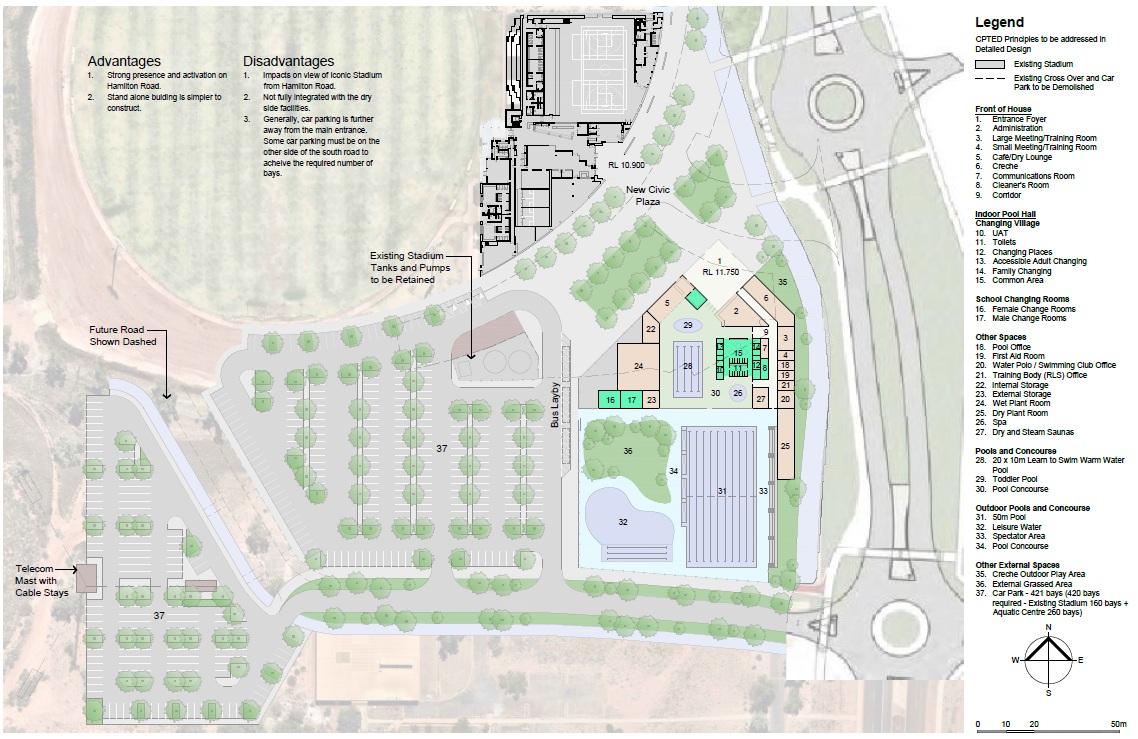Hedland aquatic facility
The Town of Port Hedland has prioritised a new aquatic facility for Hedland, with the current South Hedland Aquatic Centre (SHAC) and Gratwick Aquatic Centre (GAC) in Port Hedland nearing end-of-life.
An aquatics masterplan was endorsed by the Council in 2021, which confirmed the need for a new facility and the intention to co-locate the facility at the Wanangkura Stadium site in South Hedland.
Since 2007 the Town of Port Hedland has spent more than $7 million on critical repairs and maintenance for the two facilities, so they can remain open to the public.
In 2023 the Town was forced to close the South Hedland Aquatic Centre for the majority of the year to address critical failures.
Both aquatic centres are at the end-of-life and cost $1 million per year, per centre to ensure they can stay open for the Hedland community.
At the Town's Ordinary Council Meeting in July 2025, a preferred site was adopted adjacent to Wanangkura Stadium to allow the creation of a people-centric plaza that will link the two main buildings.
The plaza will be used for community events and activities.
Comprehensive concept designs and a cost plan will now be prepared for the site, with a report due back to council by December 2025.
The Town has received $22.5 million from the WA Government for construction of the aquatic centre, with further funding avenues being pursued.

Community benefit
The Town of Port Hedland operates two aquatics facilities: the Gratwick Aquatic Centre in Port Hedland and the South Hedland Aquatic Centre.
When available to the public, the centres are heavily utilised by a broad community cohort including:
- Aboriginal Corporations including Kariyarra AC, Nyamal AC, Julyardi and IBN
- Hedland Amateur Swim Club
- Hedland Tri Sports Association
- Hedland Water Polo Association
- Royal Life Saving Society of Western Australia
- Disability Services
- CALO Community members
- General Community
In the 12 months to April 2025 there were 146,575 visits at the Town of Port Hedland's aquatic facilities.
A detailed business case has been completed for the development of the aquatics facility.
It concluded the project would:
- Lift total economic output by $795 million
- Support development of 770 jobs (including all direct, supply-chain and consumption effects) and
- Support $33 million paid in wages
Aquatic facilities are proven to contribute to increased happiness and connection across society while also reducing the burden of disease.
Research indicates that in Western Australia social, health and economic benefits from aquatic facilities are substantial.
In regional Australia, there is an estimated $2.78 social return for every $1 spent operating Australia's current aquatic facilities, and $7.97 social return if a new aquatic facility were constructed in a regional location with unserved demand.
In the Port Hedland context, a new aquatic facility is imperative. It would facilitate significant social impact including:
Health and wellbeing
Improvements to users including mental, physical, and functional health.
Social connection
Reducing feeling of loneliness and social isolation, organised clubs and groups, families. Creating spaces that facilitate bringing people together are imperative in the development of social capital. Well developed social capital leads to stronger communities, better social support systems, improved resilience and fosters integration and inclusion.
Safety and education
Water safety, learn to swim, a safe space for the local community to play or in times of crisis.
Social cohesion
Diverse multicultural communities, learning about difference, opportunities to engage.